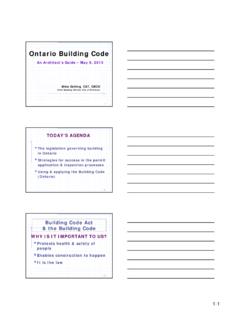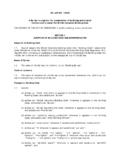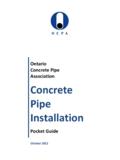Transcription of ENERGY EFFICIENCY IN THE PROVINCIAL BUILDING CODE
1 ENERGY EFFICIENCY IN THE PROVINCIAL BUILDING CODEDISCUSSION PAPER MARCH 2009 TABLE OF CONTENTS SUMMARY 1 CURRENT ALBERTA CODES 2 STANDARDS IN OTHER PROVINCES 3 WATER EFFICIENCY 8 BUILDING LABELLING 8 SOLAR READY 9 ADDITIONAL BENEFITS OF GREEN BUILDINGS 10 TACKLING CLIMATE CHANGE 11 BARRIERS TO ENERGY EFFICIENCY 11 POTENTIAL BARRIERS TO BUILDING code CHANGES 11 CONCLUSIONS 14 REVIEWERS 16 1 SUMMARY In January 2008, the Government of Alberta stated it will [i]
2 Mplement ENERGY EFFICIENCY standards in BUILDING codes for homes and commercial buildings as part of Alberta s 2008 Climate Change Strategy. Following this, in July 2008, all of Canada s premiers committed to a 20 per cent increase in ENERGY EFFICIENCY by 2020 in their respective jurisdictions. And in December 2008, the Alberta government reinforced earlier commitments by stating in its PROVINCIAL ENERGY Strategy that it will [s]trengthen BUILDING codes to ensure new housing and BUILDING stock being put in place for the future is as efficient as possible.
3 The Alberta ENERGY EFFICIENCY Alliance1 (AEEA) is a diverse group of industry, municipalities, non-profit organizations and associations dedicated to maximizing ENERGY EFFICIENCY within the province. Needless to say, the AEEA has an interest in how the Government of Alberta incorporates ENERGY EFFICIENCY within the BUILDING code and has commissioned this paper as a method of contributing to the discussion on the topic. The purpose of this paper is to look at approaches that other jurisdictions have taken to incorporate ENERGY EFFICIENCY into their BUILDING codes as possible models for Alberta to follow.
4 As will be discussed, leading provinces in this area have established similar levels of EFFICIENCY standards and are moving towards EnerGuide 80 as the minimum standard for homes within the next few years. For commercial buildings, both the Model National ENERGY code for Buildings and ASHRAE2 , an industry standard for ENERGY efficient buildings, appear to be the most common standards that provinces are instituting. Governments are also advancing the concepts of water EFFICIENCY , ENERGY labelling for all buildings and using low cost measures for houses to be built solar-ready.
5 Each of these measures delivers ENERGY and environmental savings in their own right. 1 Visit for more information. 2 American Society of Heating, Refrigeration and Air-Conditioning Engineers Efficient buildings benefit all Albertans through net cost savings and a cleaner environment. The Government of Alberta has an opportunity to become a leader in ENERGY efficient buildings by adopting progressive standards in the short-term and setting the stage for further EFFICIENCY advancements over time.
6 CURRENT ALBERTA CODES Contrary to the belief of some, the Alberta BUILDING code already contains specific minimum requirements for thermal insulation for small buildings whereas the National BUILDING code does not. Table 1 lists the requirements from the Alberta code . In contrast, there are currently no minimum requirements for thermal insulation in larger buildings built within the province. Table 1: Thermal Insulation Requirements for Small Buildings from the Alberta BUILDING code , Section Minimum Thermal Resistance Location of Assembly in Which Insulation is Placed RSI R-valueA BUILDING exterior 12 Between BUILDING and attached garage 12 Wall assembly (except basements) Exterior of heated garage 12 Basement and crawl space Perimeter walls (top to 600 mm below grade)
7 8 Perimeter 12 Floor Assembly Exposed cantilevers 20 BUILDING general 34 Roof ceiling assembly Heated garage 34 Existing Buildings It should be noted that while BUILDING codes are very useful for improving the construction of new buildings and buildings undergoing substantial renovations, the majority of buildings that will exist in Alberta in 50 years are already built, and will likely not be affected by changes to the BUILDING code , as it is now applied.
8 In order to achieve substantial reductions in greenhouse gases and savings in ENERGY costs in the majority of buildings in the province, other strategies are required. This could involve a broad BUILDING retrofit program, ENERGY labelling requirements, a renovation code (under development in Ontario and Manitoba), and/or requiring ENERGY upgrades during transfer of ownership. A Approximation calculated from the RSI value. While thermal insulation is not the only method of improving BUILDING EFFICIENCY , these standards are a starting point for helping Albertans to improve their ENERGY EFFICIENCY .
9 In fact, the Alberta Government has indicated it will, [s]trengthen BUILDING codes to ensure new housing and BUILDING stock being put in place for the future is as efficient as possible .3 The following section outlines standards that are already in place in Canada. 3 Government of Alberta. 2008. Launching Alberta s ENERGY Future: PROVINCIAL ENERGY Strategy. 23 STANDARDS IN OTHER PROVINCES This section looks at the four provinces in Canada that are currently leading the advancement of ENERGY EFFICIENCY standards in PROVINCIAL BUILDING codes: , Manitoba, Ontario and Nova Scotia.
10 British Columbia In 2008, instituted a Green BUILDING code , which requires houses to be built to insulation levels greater than those currently required in Alberta, as demonstrated in Table 2. Alternatively, builders have the option to build to an EnerGuide 77 rating level through an objective based code . The PROVINCIAL government also made it possible for local governments to increase local BUILDING code requirements in a number of areas, including ENERGY . The Government of is expected to raise the PROVINCIAL standard to EnerGuide 80 by 2010.







